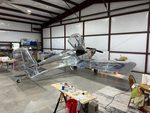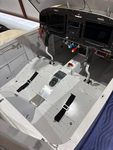First Engine Run
I would've gotten the engine started last week. But in the span of three days, I had the opportunity for Craig (A&P/IA), my good building buddy from AZ and Martin (5 RVs built) and EAA Tech Counselor to both inspect my plane. The more experienced eyes on it, the better. Between the two of them they identified a few areas that needed improvement. Nothing gross, mostly having to do with reducing rubbing/chaffing/securing and a slightly binding aileron pushrod. All were easily rectified. I welcomed their time, experience and constructive criticism. With that all taken care of I could finally get back to starting the engine. While Craig was here, we pulled all the upper spark plugs and performed the Lycoming pre-oil procedure mandated before a first start. It consists of spinning the engine with the starter to make sure oil pressure is achieved. 20 PSI is the minimum required. The first attempt of 10 seconds yielded no rise in oil pressure, probably due to air in the system. I was glad I'd filled the oil cooler previously. The second attempt saw the oil pressure rise quickly into the 40s. All good. Today I performed the same pre-oil procedure which went smoothly then re-installed the top plugs and leads. Lycoming directs the first start be performed within 3 hours of the pre-oil. I knew the first start/run would be a busy time with multiple tasks I wanted to perform in a short period of time. To organize my thoughts, reduce drama and get the maximum out of the run I created a written check list/test card with cold/hot/flooded engine start procedures, engine limits, operating/test procedures related to the ignition and other nice-to-know stuff in case I had issues. For safety I enlisted my neighbor Paul (pilot/A&P) as an observer/fire guard. We had 3 fire extinguishers available and my handheld VHF radio so he could better communicate with me. My wife Lisa was videoing the whole thing for the record. Besides wheel chocks I also bought a 24" ground anchor that I screwed into the ground behind the plane. I ran a rope from its eyelet to my tailwheel as an extra measure of security. I briefed Lisa and Paul on my plan, and how we'd handle leaks and fires. With that it was time, so I climbed in and commenced the cold start checklist that I'd created. Lycoming, AirFlow Performance (fuel injection system) and E-Mag (electronic ignition) all have recommended cold/hot/flooded start procedures that differ in subtle ways. The checklist I created blended all of them together. I'll modify it as needed as I learn the engines idiosyncrasies. After building fuel pressure with the boost pump on and then turning it off, with the throttle cracked and mixture in cutoff I cranked the engine. After just a few blades it started to fire. I moved the mixture to rich, and the engine started right up. No drama. After verifying that I had oil pressure and all gauges were registering I set 1000 RPM on the throttle for 3 minutes as directed by Lycoming to let it warm up. During that time I monitored things and went from Left to Right on my fuel selector valve to make sure fuel fed from both tanks After three minutes I increased power to 2000 RPM and cycled the prop control to get oil in the prop hub. 3 cycles yielded normal RPM drops as the prop cycled to coarse pitch and back. I then checked my PMags individually by selected left and right and noting the RPM drop and difference which were well within limits. I then tested the internal PMag alternators using the two ignition Test switches on my panel and then performed the PMAG Minimum Operating Speed test starting at 1300 RPM. By selecting individual ignitions, holding the ignition Test switch to isolate ships power and slowly reducing the throttle to idle I was able to determine that both PMags dropped offline at approximately 800 RPM which in nominal. I then checked min idle speed which was about 550 RPM which is below the nominal 700-750 RPM so that might need an adjustment. I reestablished 1000 RPM for 30 seconds to let everything stabilize then shut down with the mixture to cutoff. A post flight inspection showed no leaks or drips. It was super satisfying to get the engine running after 5+ years of building. That is started so quickly and easily and ran well was icing on the cake. With my wife's video I could easily see that my spinner spun true with no wobbling that some RVs have. There's more to do but I'm getting closer to flying every day.
This post is from Scott's RV-14 Build

